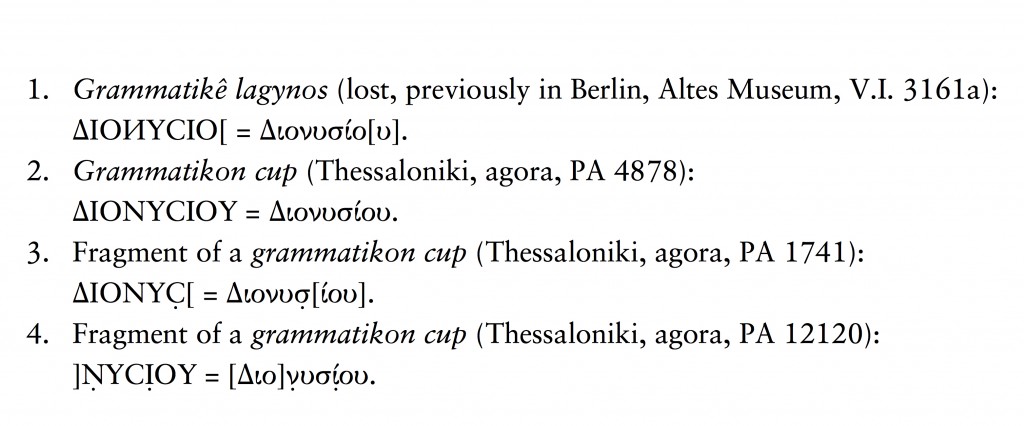Citation with persistent identifier:
Nasioula, Maria. Διονύσιος: Τhe grammarian, the potter and the ghosts. CHS Research Bulletin 5, no. 2 (2017). http://nrs.harvard.edu/urn-3:hlnc.essay:NasioulaM.Dionysios.2017
τοιοῦτον εἴδομεν ποτήριον γραμματικὸν ἀνακείμενον ἐν Καπύῃ τῆς Καμπανίας τῇ Ἀρτέμιδι, ἀργυροῦν, ἐκ τῶν Ὁμηρικῶν ἐπῶν κατεσκευασμένον καὶ ἐντετυπωμένα ἔχον τὰ ἔπη χρυσοῖς γράμμασιν, ὡς τὸ Νέστορος ὄν.
Athenaeus Deipnosophists XI 466e
§1 Three major questions arise when one comes to consider the grammatika vases: who created them, for whom and why? My intention today is to answer all three by using only one name as a guiding thread: Διονύσιος.
§2 To begin with, however, I would like to take a few minutes to define what I mean exactly by the term grammatika vases. Following Athenaeus, who describes a silver ποτήριον γραμματικὸν with scenes and verses inspired by the Homeric poems[1], I have suggested the use of the term γραμματικὰ ποτήρια (grammatika cups) or, more generally, grammatika vases, for defining specifically the Hellenistic relief vases with inscribed narrative scenes[2]. This type of molded vessel comprises one of the most distinctive varieties of Hellenistic relief pottery –at a glance, because it features two basic conspicuous elements: the narrative scenes and the inscriptions; after a closer look, for the strong reliance of its iconography on literary sources. In search of a name that would encompass all these qualities, complying at the same time with the requirements of modern terminology, Athenaeus’ testimony about the γραμματικὸν ποτήριον or ἔκπωμα provided the answer. The term he uses not only describes the existence of inscriptions on the surface of the vases, but also acts as a reminder of their strong connection with γραμματική, namely ancient Greek literature as a whole[3].
§3 By aiming to analyze the details of this puzzling relationship between γραμματικὴ τέχνη on the one hand and γραμματικὸν ποτήριον on the other, I will attempt a fresh reading of the written sources, focusing on the quest of their common denominator, none other than the γραμματικός himself, and I will investigate his role in the achievement of this special fusion of literature and scholarship on the surface of everyday vessels.
§4 Before I proceed, however, some clarifications regarding the iconography are indispensable. The comparative study of the material has shown that the potters of grammatika vases confine themselves exclusively to literary subjects[4]. The compositions illustrate episodes of the most classical, even canonical, literary works, or works that give a hint of the popular entertainment of the times, extending from heroic epic to drama and from kinaidos to erotic literature, and thus covering as a whole the wide range of literature suitable or preferable for a symposium[5].
§5 Τhe reliance of the iconography on literary sources is demonstrated by the inscriptions themselves, which represent the most essential element of the decoration. A thorough study of their text[6] reveals that, apart from the signatures and monograms, all other inscriptions are related to the narrative scenes and fall into four major groups: the first one includes names (proper or common nouns defining the depicted persons or objects)[7], the second citations (quotations of famous passages of the literary texts)[8], the third dialogues (phrases or clauses of direct speech within dialogues between the depicted persons)[9], and the last one descriptive texts (phrases, clauses or more extensive texts that provide information about the decorative subject, the content of individual scenes, the author, and the title of the literary work).
§6 The information harvested from all these inscriptions is invaluable. Apart from their content — which enriches our knowledge of Greek literature and its reception during the Hellenistic period — their vocabulary and syntax, as well as their layout and letter forms are comparable to those in literary and subliterary papyri, revealing an impressive correspondence. More specifically, the appearance of lectional signs (namely, the paragraphos, the midline dash or the dicolon) in the citations exactly matches the way they are used in the literary — mostly poetic — texts in papyri, while the prose summaries of the depicted myths or poems’ episodes resemble the hypotheses of literary works in subliterary papyri. These features, together with the philological comments about the content of the depicted myths, and the intense and scholastic preoccupation with the recording of poets’ names and works’ titles are only few of the most conspicuous characteristics of the inscriptions on grammatika vases, and they indicate nothing less than scholarly attention and activity[10].
§7 This fact, in combination with the archaeological data that point to a sympotic environment and context, forces us to restate the critical question that has been left in suspense since the beginning of this talk: who would have created such a pottery — and for whom and why would someone have created such a pottery — which in a most unique and unprecedented way advances the role of the image, designating its narrative power rather than its decorative use, and draws the viewer’s attention from literature to scholarship, presenting a new star in the place of the hero and a new authority in the place of the poet: the grammarian himself?
§8 In order to answer this complex question, I will start my investigation with the information that the archaeological objects themselves provide, turning first to the signatures. Unlike all the other varieties of moldmade bowls, where most of the inscriptions are designations of shops[11], within the frame of the 220 grammatika vases recorded so far[12], only four examples bear signatures[13]: a lagynos from Anthedon (?) with scenes inspired by the myth of Sisyphos and Autolykos (Figure 1)[14], a cup (Figure 2)[15] along with a fragment (Figure 3)[16] from the ancient agora of Thessaloniki, featuring episodes that draw on Book 4 of the Iliad, and a second fragment from the same context bearing erotic scenes (Figure 4)[17]; and it is perhaps not accidental that all four examples preserve the same name in genitive: Διονυσίου:
§9 Although attractive, the possibility that all these signatures come from the same hand must be excluded. The study of their letter forms and position on the surface of the narrative frieze lead to the conclusion that only the three of them — those which in any case came from the same archaeological context — were signed by the same person: a potter named Διονύσιος, who either worked in Thessaloniki or manufactured vases that were sold there. What is more, since his hand does not appear on other grammatika vases, it is very probable that this Διονύσιος was a local potter. The fourth signature, on the other hand, must be ascribed to a different potter, another Διονύσιος proud of his products — the namesake of the Macedonian one, but a completely different person[18]. Yet, the lunate letter forms of the vase — whose origin is, at any rate, uncertain, due to the illegal antiquities trade — demonstrate that it must be a Macedonian product as well, though its decorative subject points to Pella’s workshops rather than those of Thessaloniki[19]. Whatever the case, the conclusion drawn so far from the study of the signatures on grammatika vases is that two different Διονύσιοι, one from Thessaloniki, the other of unknown — most probably Macedonian — origin, were involved in the production of at least four of the 220 grammatika vases.
§10 Nevertheless, due to the special character of the iconography, we should probably not jump to the self-evident, yet premature, conclusion that the signatures belong to the potters of the vases. The supposition that we could ascribe them to another person — someone more closely related to the inspiring literary source rather than to the manufacturing process itself — is if nothing else a very usable working hypothesis. The very position of these inscriptions on the main narrative frieze and, indeed, on zones where in other examples the poets’ names and the works’ titles appear[20], allows us to investigate at least the possibility that they cite the author of the work that inspired the potters, even though the variety of decorative subjects excludes the probability that this author would be the poet of the original works. Yet, who else would have the authority to collect under the same signature all these miscellaneous subjects, if not the potter himself? Before we give in to the obvious, it is worth investigating the idea of a more or less contemporary mythographer or even a composer of an illustrated handbook or any other potential source that could intervene between the poet and the potter; namely, another authority that the producer of the vases needed to invoke in order to convince his target audience about the literary character of his products.
§11 How usable and not at all improbable this hypothesis is, can be justified by the high number of the candidates: the ancient writers bearing the name Διονύσιος[21]. This very popularity, of course, in combination with the often-fragmentary preservation of their works and the sometimes-vague information about their lives, is also what makes the identification process more difficult. However, despite the plethora of possibilities and uncertainties, even a quick review of the available sources would suffice to single out the case of Διονύσιος Κυκλογράφος, the Samian or Rhodian mythographer of the third century BCE, who was the author of the Κύκλος, a mythographical handbook, to which Athenaeus and other sources refer and even quote in several cases of mythological interpretation or dispute[22]. The Κύκλος of Διονύσιος was written in “a very plain and simple prose” and “covered the ancient —mythical — history narrated also in the epic poems”[23], from the beginning of the world (theogony) to the end of the heroic age (death of Odysseus). This thematic frame, as the basic common denominator among epic poems, Dionysios’ narrations, and the iconography of grammatika vases, strings together ancient Greek literature, Hellenistic mythography, and everyday art, respectively. On the other hand, the language used in Κύκλος, since it is comparable with the prose texts of several grammatika vases, places them closer to works like the one of Dionysios rather than to the original epics.
§12 In view of this correspondence, we must admit that the case of this third Διονύσιος of our study deserves a more thorough investigation in relation to grammatika vases. For, despite the scarcity of evidence, it seems that the impact of his work on his contemporaries and on scholarship in general was not insignificant. What is more, the knowledge we now have about grammatika vases forces us to evaluate the information about Dionysios’ work in quite a different light. But the most important thing is that his case gives to our quest a completely new direction, pointing towards a world rather far from the one of pottery workshops and closer to that of libraries. Thus, even if we had to admit that the signatures on the four grammatika vases belong to the potters, the case of Κυκλογράφος Διονύσιος functions as one of the possible missing links between these potters and the poets. After all, this chasm between the laborers and the scholars is the actual distance that one has to bridge, in the first place, in order to interpret the phenomenon of the final composition of image and text on the surface of everyday vessels[24].
§13 However, the seemingly growing list of Διονύσιοι in this study does not end here. Coincidentally, another Διονύσιος — better known than the vague personalities of our potters and the mythographers around them — definitely spent a great part of his life in Rhodes, and is well attested by the ancient writers: Διονύσιος Θρᾷξ[25]. What is not well known, though, and what I am going to argue during this presentation, is his close relationship with grammatika vases.
§14 Dionysios Thrax was an Alexandrian grammarian and one of the most prominent and devoted pupils of Aristarchos of Samothrace — the supreme authority in criticism and interpretation of literary texts, especially Homer. How close the relationship between teacher and pupil was can be ascertained from a well-known anecdote, according to which Dionysios portrayed his teacher, Aristarchos, with the tragic Muse on his chest, διὰ τὸ ἀποστηθίζειν αὐτὸν πᾶσαν τὴν τραγῳδίαν[26]. This backstage episode is very telling not only about the high degree of the master’s literary competence — he had the reputation of being able ‘to recite the whole tragedy by heart’, anyway — but also about the pupil’s artistic talent which matched the knowledge of grammar he possessed[27]. As a native of Alexandria, Dionysios lived and worked there for the greater part of his life. However, in 144/3 BC, a serious crisis took place in Egypt, determining the development in its intellectual life. The legitimate king Πτολεμαῖος Νέος Φιλοπάτωρ (Ptolemy VII) was murdered, and his uncle Πτολεμαῖος Εὐεργέτης (Ptolemy VIII), as he styled himself, usurped the throne. This political upheaval provoked “the first great crisis” in the history of Greek scholarship in Alexandria, yet with an impact that reached beyond Egypt. The usurper persecuted all his nephew’s learned friends, among whom his own mentor and tutor of the whole royal family Aristarchos; an act which explains the apt nickname Κακεργέτης, which he was given by the Alexandrians[28]. Along with a great number of scholars, who were compelled to migrate to other economic and cultural centers in order to survive, Aristarchos escaped to Cyprus, where “he is assumed to have died shortly afterwards,”[29] while Dionysios followed his teacher’s fate and established his own school in Rhodes[30]. An undoubtedly significant setback for the library of Alexandria had a beneficial effect on the distribution of knowledge in all other areas of the Greek speaking world and especially the Greek mainland.
§15 Not many details about Dionysios’ life in Rhodes have survived, but the single episode briefly narrated by Athenaeus (XI 489a–b) seems to make up for all the silence: Διονύσιος δὲ ὁ Θρᾷξ ἐν Ῥόδῳ λέγεται τὴν Νεστορίδα κατασκευάσαι τῶν μαθητῶν αὐτῷ συνενεγκάντων | τἀργύριον. According to Athenaeus, who delivers what “is said,” Dionysios of Thrace, using silver contributed by his pupils at Rhodes, reconstructed the Νεστορίς –the δέπας περικαλλές, which belonged to Nestor and which, according to the Iliad (XI 632–637), ἄλλος μὲν μογέων ἀποκινήσασκε τραπέζης | πλεῖον ἐόν, Νέστωρ δ’ ὁ γέρων ἀμογητὶ ἄειρεν. This small piece of information is illuminating in and of itself, confirming everything we know about Dionysios: his intellectual along with his artistic curiosity, both inspired by the love for Homer, in whom his main scholarly interest was focused. The description that follows in Athenaeus (XI 489b–c), however, makes it one of the most crucial and thrilling of all regarding the grammatika vases: ὁποῖόν τι καὶ νῦν ἔστιν ἰδεῖν ἐν Καπύῃ πόλει τῆς Καμπανίας ἀνακείμενον τῇ Ἀρτέμιδι ποτήριον, ὅπερ λέγουσιν ἐκεῖνοι Νέστορος γεγονέναι· ἐστὶ δὲ ἀργύρεον, χρυσοῖς γράμμασιν | ἐντετυπωμένα ἔχον τὰ Ὁμηρικὰ ἔπη. After delivering the testimony of Promathidas of Heracleia (FGrH 430 F 8), who describes Dionysios’ design, Athenaeus stresses that it is still possible to see today what this Νεστορίς was like, referring to a silver cup with the Homeric verses embossed on it, dedicated to Artemis in Capua, which the locals claim belonged to Nestor[31]. In other words, Athenaeus correlates the Νεστορίς reconstructed by Dionysios with a cup extant in his time, actually describing it as a ποτήριον γραμματικόν.
§16 The importance of this conclusion is demonstrated by the ancient text itself; for — in a quite amazing way — it matches perfectly the other piece of information that Athenaeus delivers a few entries earlier in his catalogue (XI 466e), trying to define and document the term γραμματικὸν ἔκπωμα: τοιοῦτον εἴδομεν ποτήριον γραμματικὸν ἀνακείμενον ἐν Καπύῃ τῆς Καμπανίας τῇ Ἀρτέμιδι, ἀργυροῦν, ἐκ τῶν Ὁμηρικῶν ἐπῶν κατεσκευασμένον καὶ ἐντετυπωμένα ἔχον τὰ ἔπη χρυσοῖς γράμμασιν, ὡς τὸ Νέστορος ὄν. The rhetor of the day in the symposium of Δειπνοσοφισταί, the Alexandrian grammarian Plutarch[32] — or Athenaeus himself, behind him — after giving the definition of γραμματικὸν ἔκπωμα and Alexis’ testimony about an inscribed metal cup, testifies as an eyewitness about a silver ποτήριον γραμματικόν in Capua, which has exactly the same characteristics as the Νεστορίς of Dionysios and — what is more — its design is inspired by the Homeric poems.
§17 The correlation between the two vases, namely the ποτήριον γραμματικόν that Athenaeus or Plutarch saw in Capua and the Νεστορὶς that Dionysios reconstructed following the description of the Homeric text — which constitute, after all, the only two cases within the catalogue of the vases (κατάλογος τῶν ποτηρίων), for which Athenaeus delivers a precise description of their decoration[33] — allows for some very interesting remarks. The first one has to do with the fact that the two vases coincide, namely that they are the same vase, as can be concluded by the wording of the ancient text[34]. The second one has to do with the Νεστορὶς of Dionysios itself and its description as a grammatikon cup. Leaving aside for the moment the very intriguing discussion about the first[35], I will focus exclusively on the second point, stressing its immediate interest for our subject. For, whether we accept that the cup in Campania coincides with the actual Νεστορίς that Dionysios constructed or not, we must admit that these two vases were at least similar[36]; and this similarity actually has to do with the decoration — the verses and most probably the depictions that draw on the Homeric epic, since these are the details that Athenaeus repeats in both passages, in order to document the correlation. In other words, the Νεστορίς of Dionysios was in fact a grammatikon cup, whether identical or not with the ποτήριον γραμματικὸν of Capua[37]. But even if Νεστορίς was not decorated with citations and scenes that draw on the Homeric epic, it could still be implicitly considered as a grammatikon cup, since its inspiration draws on the Homeric text alone and this is the epitome of literacy (γραμματικότης).
§18 In view of this conclusion, we can now place the information in its historical context: After the middle of the second century BCE and definitely after the subjugation of the Macedonians and the rest of the Greeks to Rome[38], a great grammarian, in an island far away from Alexandria, Athens, Boeotia and even Macedonia (where most of the grammatika vases have been found), engages with the reconstruction of Nestor’s cup, following the Homeric text[39], which he knew by heart. At exactly the same time, Διονύσιος of Thessaloniki — and most probably his namesake potter of the Macedonian lagynos as well — was putting his signature on the clay versions of the Νεστορίς in his unknown workshop, in order to furnish his customers’ symposia, where his creations would have stimulated guests to start long conversations, featuring citations of the texts[40]. It is impossible for me to escape from the Homeric connotations that this everyday Hellenistic scene has, knowing that Nestor (Iliad XI 642) did exactly the same thing with his companions, after they “were rid of their thirst’s parching”[41], using his legendary cup: τὼ δ’ ἐπεὶ οὖν πίνοντ’ ἀφέτην πολυκαγκέα δίψαν, | μύθοισιν τέρποντο πρὸς ἀλλήλους ἐνέποντες.
§19 Albeit small within the extensive entry of Athenaeus on the Νεστορίς, the information regarding Dionysios Thrax proves to be precious for its content, since it provides us with the only testimony about the time, the place and the way in which a grammatikon cup was constructed. What is more, it constitutes the only known case of a metal grammatikon vase, for which we have the full description of its decoration, along with a documented ancient term. But most importantly, it provides us with the name of its constructor, who was neither just a famous metalworker from Rhodes nor an unknown potter of Macedonia, but one of the prominent grammarians of Alexandria, and — indeed — one who was a competent artist as well. Undoubtedly, this is a very well documented historical scenario regarding the initial inspirer and creator of a grammatikon vase, its possible users and the historical, social, and literary contexts which explain the reasons for its introduction and establishment as an everyday cup.
§20 If not Dionysios Thrax, then definitely some other grammarian — more or less important, Alexandrian or not — took the initiative to transfer to metal or clay citations and scenes from popular works of Greek literature and to mark the beginning of a new fashion in pottery production; a vogue which corresponded to the new trend of the times not only for a return to the past but for the demonstration of erudition in art and literature as well[42]. It is not at all improbable that this trend began in the Macedonian palace or in the Alexandrian library or any other Hellenistic court, where the grammatika vases would function as the ideal companion at symposia and the perfect excuse for neverending literary conversations between the scholars and their patrons. In any case, the conditions for the whole phenomenon existed and were more than ideal[43].
§21 Following a journey through time and space, I tried to bridge the enormous distance between the Macedonian pottery workshops and the Hellenistic libraries and schools, using as a guiding thread one of the most popular names of antiquity[44] and one of the many comprehensive terms that Greek language has gifted us. At the end of this quest, I believe, we are more capable to evaluate the suggested term γραμματικὰ ποτήρια for the definition of this special group of vases. It is quite a gift — and not a coincidence this time — that Dionysios Thrax himself starts his Τέχνη (Technê grammatikê 1) with a definition[45] that not only “is in the best Alexandrian tradition”, as Pfeiffer would have said[46], but also interprets its correlation with the grammatika vases, as well as its use by Athenaeus: Γραμματική ἐστιν ἐμπειρία τῶν παρὰ ποιηταῖς τε καὶ συγγραφεῦσιν ὡς ἐπὶ τὸ πολὺ λεγομένων. In that sense, there is no other term that would more appropriately define this type of pottery; nor could this comprehensive term be more suitable for any other group of inscribed vases than the one in question. With these connotations in mind, it is also clear that the four signatures on the Macedonian vases, though they most probably correspond to their unknown potters, they conceal now a more complex meaning. Is it a mere coincidence that all the basic stages in the creation of a grammatikon vase –from its first inspiration to its final production– are connected with a Διονύσιος? Maybe not. What really matters is that the distance between the labourers and the scholars that determines the character of this study, albeit enormous, has now been bridged.
Bibliography
Adam-Veleni, P., P. Georgaki, and E. Zografou. 2011. «Ανάγλυφοι σκύφοι με αφηγηματικές παραστάσεις από την Αγορά Θεσσαλονίκης». 7th Scientific Meeting on Hellenistic Pottery, Aigio, 4-9 April 2005, ed. M. Kazakou, 813–820, pl. 331–334. Athens.
Akamatis, I. 2010. “Homer in Florina.” In Palagia and Wescoat 2010:222–239.
Boardman, J. 2002. The Archaeology of Nostalgia. How the Greeks re-created their mythical past. London.
Bradfer-Burdet, I., B. Detournay, and R. Laffineur, eds. 2005. ΚΡΗΣ ΤΕΧΝΙΤΗΣ, L’ ARTISAN CRÉTOIS. Recueil d’ articles en l’ honneur de Jean–Claude Poursat, publié à l’ occasion des 40 ans de la découverte du Quartier Mu. AEGAEUM 26. Université de Liège, Histoire de l’ art et archéologie de la Grèce antique and University of Texas at Austin, Program in Aegean Scripts and Prehistory.
Braun, L. 1973. “Hellenistische Erklärungen des Nestorbechers.” Mnemosyne, F.S. 26.1:47–54.
Cavallo, G., and H. Maehler. 2008. Hellenistic Bookhands. Berlin.
Ceccarelli, P. 2009. “Dionysios of Samos (15).” BNJ. Consulted online on 5 April 2017.
Farnoux, A. 2005. “Art et litterature: La coupe de Nestor.” In Bradfer-Burdet, et al. 2005:89–96.
Gulick, Ch. B., ed. and trans. 1933. Athenaeus. Vol. 5, The Deipnosophists. Loeb Classical Library 274. Cambridge, MA.
Gulletta, M. I. 1991. “Il lessico dei vasi in Ateneo: macro e micro struttura del libro XI dei ‘Deipnosophistai’.” GIF 43:299–310.
Kaibel, G., ed. 1887–1890. Athenaei Naucratitae Dipnosophistarum Libri XV. 3 vols. Leipzig.
Koumanoudis, S. 1884. «Σκύφοι βοιωτικοί δύο». AEph 23:59–66.
Lallot, J. 1998. La Grammaire de Denys le Thrace. Traduction annotée. 2e éd. Paris.
Lattimore, R. A., transl. 2011. The Iliad of Homer. Chicago.
Linke, K., ed. 1977. Die Fragmente des Grammatikers Dionysios Thrax. SGLG 3:1–77. Berlin.
Manakidou, F. P., and K. Spanoudakis, eds. 2008. Αλεξανδρινή Μούσα. Συνέχεια και νεωτερισμός στην ελληνιστική ποίηση. Athens.
Matthaios, S. 2008. «Ποιητὴς ἅμα καὶ κριτικός: η φιλολογική ταυτότητα των ελληνιστικών ποιητών και η ποιητική καταγωγή της φιλολογίας». In Manakidou and Spanoudakis 2008:545–643.
———. 2015. “Greek Scholarship in the Imperial Era and Late Antiquity.” In Montanari, et al. 2015:184–296.
Montana, F. 2015. “Hellenistic Scholarship.” In Montanari, et al. 2015:60–183.
Montanari, F., S. Matthaios, and A. Rengakos, eds. 2015. Brills Companion to Ancient Greek Scholarship. Leiden.
Mori, A. 2011. “Dionysios (‘The Thracian’) of Alexandria (512).” BNJ. Consulted online on 6 April 2017.
Nasioula, M. 2005. Οι επιγραφές στους ανάγλυφους «ομηρικούς» σκύφους, 2 vols. Thessaloniki. Unpublished Master’s Thesis, Aristotle University of Thessaloniki.
———. 2006. «Πήλινα γραμματικὰ ποτήρια από τη Θεσσαλονίκη». Θεσσαλονικέων Πόλις 19:56–71.
———. 2009. “Ἔκπτωτα Ἐκπώματα. Erotic grammatika vases.” In Stampolidis and Tassoulas 2009:58–69.
———. 2012. «Γραμματικά αγγεία. Η μελέτη των επιγραφών.» 9th International Scientific Meeting on Hellenistic Pottery, Thessaloniki, 5-9 December 2012, ed. M. Kazakou. In press.
———. 2013. «ΠΟΤΗΡΙΟΝ ΓΡΑΜΜΑΤΙΚΟΝ». Ελληνιστικά ανάγλυφα αγγεία με ενεπίγραφες διηγηματικές παραστάσεις, 3 vols. Thessaloniki. PhD diss., Aristotle University of Thessaloniki):
http://hdl.handle.net/10442/hedi/36266, http://thesis.ekt.gr/thesisBookReader/id/36266#page/1/mode/2up).
———. 2015. “«…ἐκ τῶν Ὁμηρικῶν ἐπῶν κατεσκευασμένον…». Drinking literature down in a ποτήριον γραμματικόν.” Daily life in a cosmopolitan world. Pottery and culture during the Hellenistic period, 2nd Conference of the International Association for Research on Pottery of the Hellenistic Period (IARPotHP), Lyon, 5-8 November 2015, ed. A. Peignard-Giros. In press.
Olson, D. S., ed. and trans. 2009. Athenaeus: The Learned Banqueters. Books 10.420e-11. Loeb Classical Library 274. Cambridge, MΑ.
Palagia, O., and B. D. Wescoat, eds. 2010. Samothracian Connections. Essays in honor of James R. McCredie. Oxbow Books, published in collaboration with the American School of Classical Studies at Athens. Oxford.
Pfeiffer, R. 1968. History of Classical Scholarship: From the Beginnings to the End of the Hellenistic Age. Oxford.
Pollitt, J. J. 1986. Art in the Hellenistic Age. Cambridge.
Puppo, P. 2011. “Problematiche inerenti la produzione e la diffusione delle coppe omeriche.” 7th Scientific Meeting on Hellenistic Pottery, Aigio, 4-9 April 2005, ed. M. Kazakou, 629–634, pl. 269–270. Athens.
Robert, C. 1890. Homerische Becher. Archäologische Gesellschaft zu Berlin. Programm zum Winckelmannsfeste 50:1–96. Berlin.
Rogl, C. 2001. “Töpfersignaturen auf hellenistischen Reliefbechern: eine Liste.” Ojh 70:135–155.
Rostovtzeff, M. 1937. “Two Homeric Bowls in the Louvre.” AJA 41:86–96.
Rotroff, S. I. 1982. Hellenistic Pottery: Athenian and Imported Moldmade Bowls. The Athenian Agora 22. Princeton.
Rusten, J. S. 1982. Dionysius Scytobrachion. Papyrologica Coloniensia 10. Opladen.
Squire, M. 2010. “Texts on the Tables: The Tabulae Iliacae in their Hellenistic literary context.” JHS 130:67–96.
Stampolidis, N. C., and Y. Tassoulas, eds. 2009. Eros. From Hesiod’s Theogony to Late Antiquity. Museum of Cycladic Art. Athens.
Swiggers, P., and A. Wouters. 1998. De Tékhnē Grammatikḗ van Dionysius Thrax: De oudste spraakkunst in het Westen. Inleiding, vertaling en noten door Pierre Swiggers – Alfons Wouters (met Duitse vertaling door Wilfried Kürschner). Leuven.
West, M., ed. 1998. Homerus Ilias Volumen Prius Rhapsodias I-XII Continens. Stuttgart.
Figures
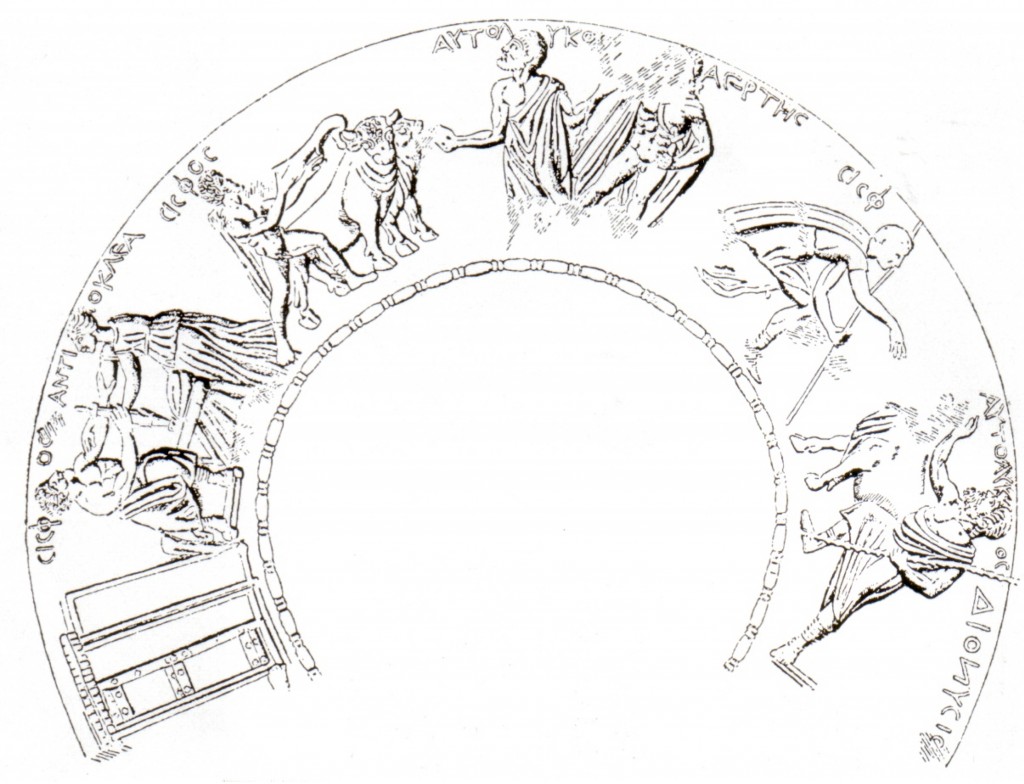
Lost, previously in Berlin, Altes Museum, V.I. 3161a.
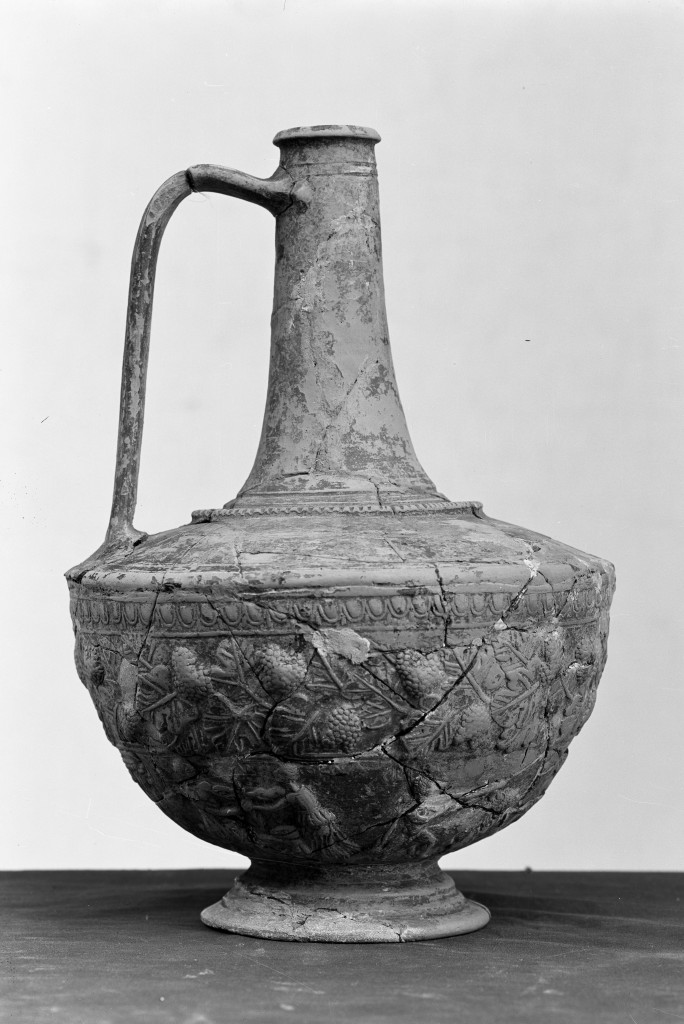

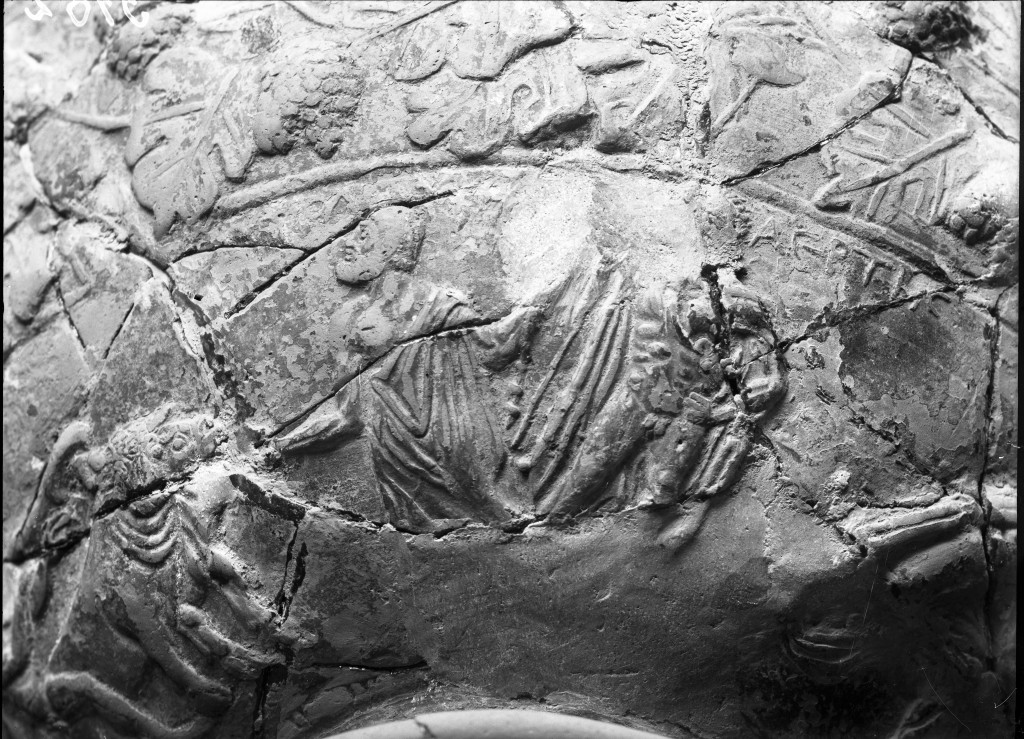
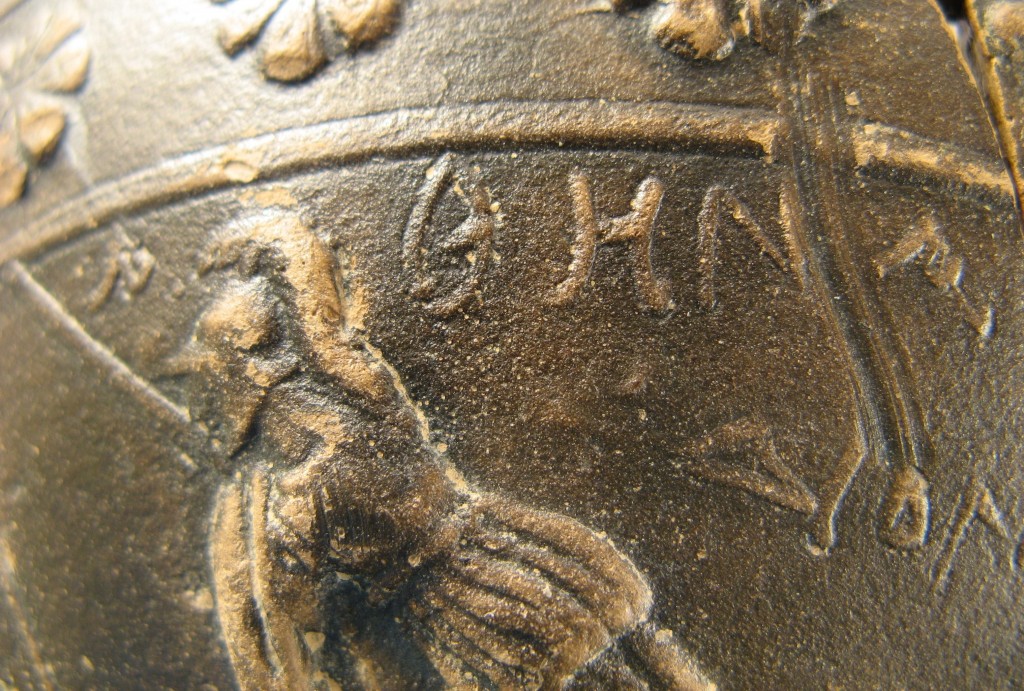
Thessaloniki, Ancient Agora, PA 4878.
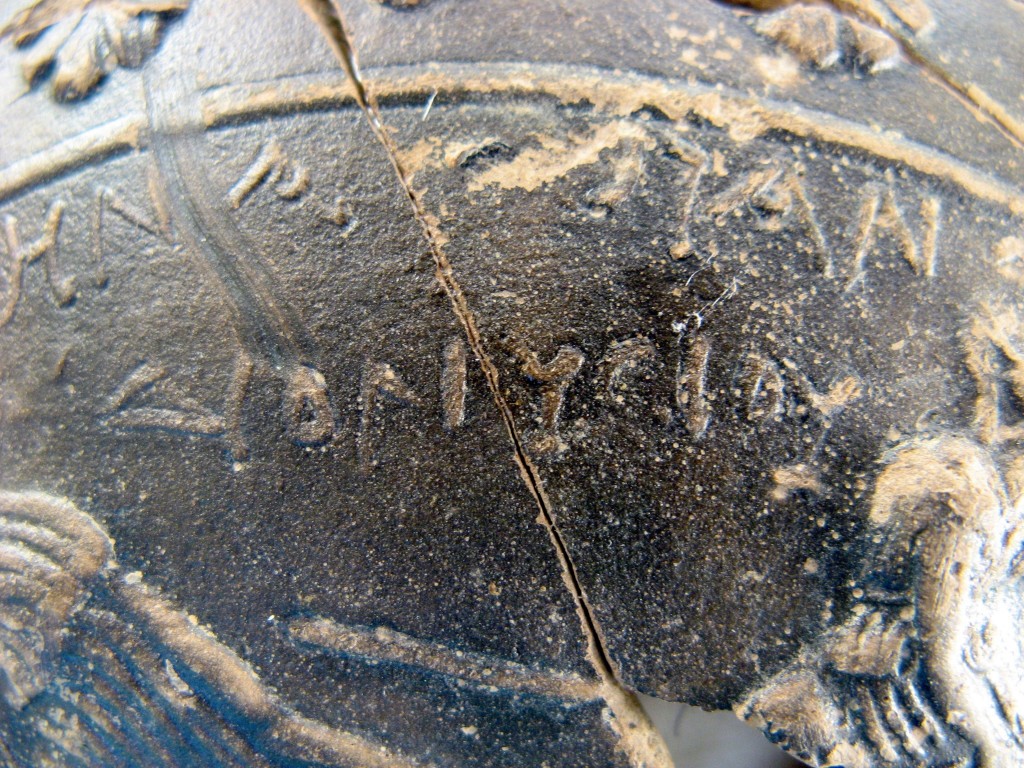
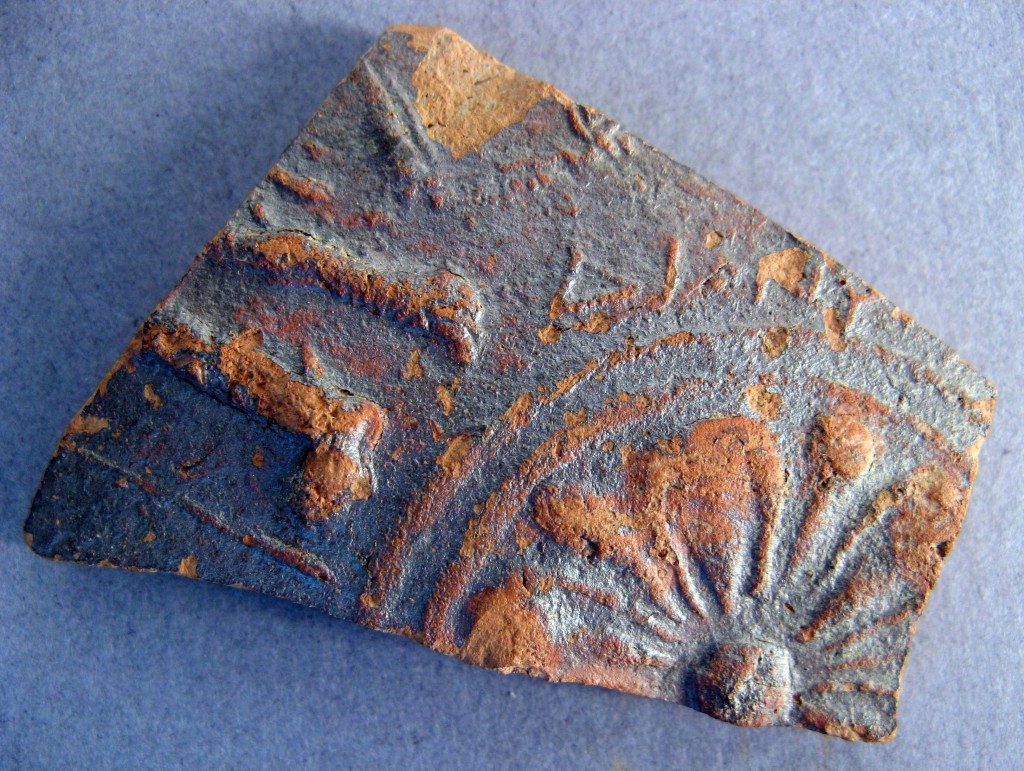
Thessaloniki, Ancient Agora, PA 1741.
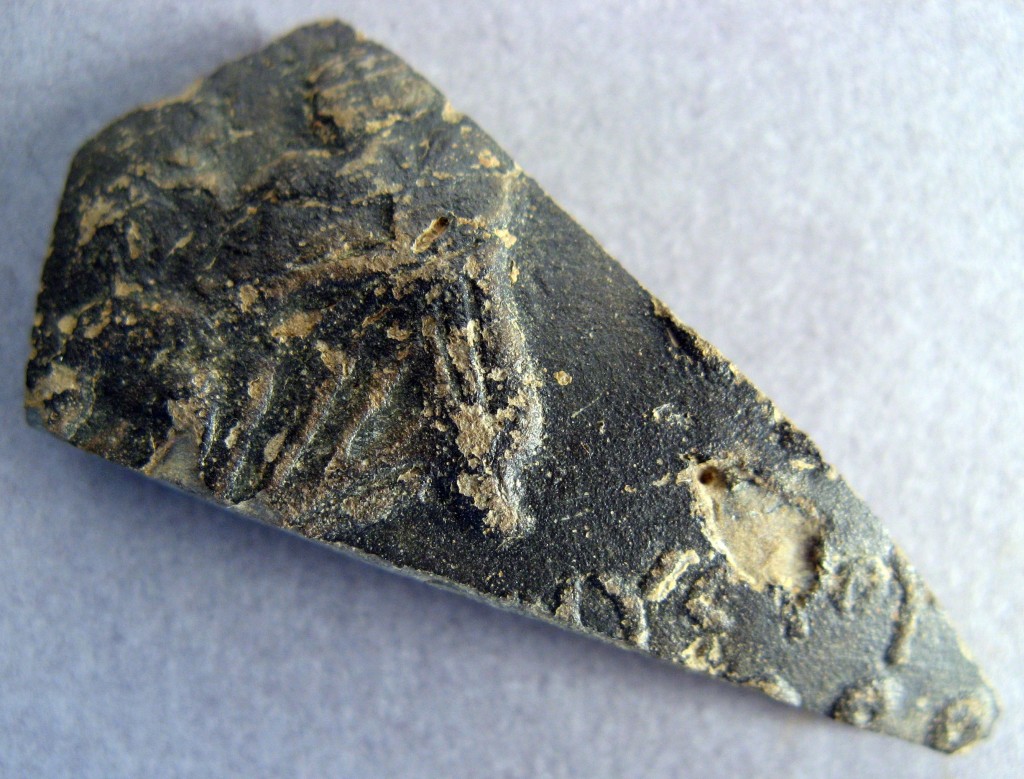
Thessaloniki, Ancient Agora, PA 12120.
Acknowledgements
The authorities of the following museum are warmly thanked for photographs and permissions:
- Antikensammlung, Staatliche Museen zu Berlin, Preussischer Kulturbesitz.
The authorities of the following ephorate are warmly thanked for permissions:
- Ephorate of Antiquities, Thessaloniki (photography by the author).
Sources of other illustrations:
- Robert 1890:93 – Figure 1a.
* My thanks are due to Professors K. Tsantsanoglou and A. Rengakos for useful suggestions and bibliographical advice. I am also indebted to Jan-Mathieu Carbon for reading a draft of this paper.
[1] Athenaeus Deipnosophists XI 466e: τοιοῦτον εἴδομεν ποτήριον γραμματικὸν ἀνακείμενον ἐν Καπύῃ τῆς Καμπανίας τῇ Ἀρτέμιδι, ἀργυροῦν, ἐκ τῶν Ὁμηρικῶν ἐπῶν κατεσκευασμένον καὶ ἐντετυπωμένα ἔχον τὰ ἔπη χρυσοῖς γράμμασιν, ὡς τὸ Νέστορος ὄν. See also Olson 2009:263: “I saw a grammatikon cup of this type dedicated to Artemis in Capua in Campania; it was made of silver, the design was inspired by the Homeric poems, and it had the verses engraved on it in gold letters that identified it as Nestor’s property”.
[2] Nasioula 2005:4–5, 2006:66–68, 2009:58, 2012, 2013:103–139, 2015. A revised edition of my PhD has been already completed (in press) and includes all the necessary updates on the aspect of ancient name and modern terminology regarding the grammatika vases.
[3] Pfeiffer 1968:156–162. See also Matthaios 2008:561, 563n41 and 2015:196–210.
[4] Nasioula 2013:279–420 and 2015. There is not a single case where the main narrative frieze is adorned with realistic scenes of daily life or even meaningless mythological scenes; see also Koumanoudis 1884:61–62, Rostovtzeff 1937:86–87, and Nasioula 2009:59–60, including previous bibliography.
[5] Nasioula 2013:488–491.
[6] Nasioula 2013:421–491, including all the statistical data.
[7] The full discussion on the name-inscriptions of grammatika vases in Nasioula 2012 and 2013:421–491 passim.
[8] The full discussion on the citations of grammatika vases in Nasioula, M. (to be submitted). Ἀπὸ στήθους. The Citations on Grammatika Vases.
[9] Dialogues almost always accompany erotic scenes. The full discussion on the erotic grammatika vases in Nasioula 2009.
[10] See also Cavallo and Maehler 2008:21–24.
[11] Rotroff 1982:40. See also Rogl 2001.
[12] The full catalogue of the 216 of them in Nasioula 2013, vol. II.
[13] Nasioula 2013:443–449.
[14] Nasioula 2013:169–170 (vol. II, no 131).
[15] Nasioula 2013:23–24 (vol. II, no 16).
[16] Nasioula 2013:25–26 (vol. II, no 18).
[17] Nasioula 2013:203–204 (vol. II, no 155).
[18] Nasioula 2006:57–60. See also Adam-Veleni et al. 2011:816n9, 819, 820. Cf. Akamatis 2010:233n52.
[19] The full discussion in Nasioula 2013:443–449.
[20] Nasioula 2005:231–232.
[21] Brill’s New Jacoby offers a list of at least 13 historians.
[22] See Ceccarelli 2009; also Rusten 1982.
[23] Ceccarelli 2009.
[24] See also Squire 2010:72–77, who discusses the same phenomenon, studying the Tabulae Iliacae.
[25] See Pfeiffer 1968:266–272, Linke 1977:5–13, and Mori 2011, including previous bibliography.
[26] Scholia Vaticana in Dionysii artem (Linke 1977:7 [T.6.b]); cf. Eustathios zu Homer Il. 974 (Linke 1977:7–8 [T.6.e]).
[27] Pfeiffer 1968:224n1, including previous bibliography.
[28] Athenaeus Deipnosophists IV 184b–c.
[29] Pfeiffer 1968:211.
[30] Pfeiffer 1968:266–267. On Rhodes as a cultural center of the early Hellenistic age see Montana 2015:72–74, 75–76, 163–165.
[31] See Gulick 1933:177; cf. Olson 2009:379. I prefer Gulick’s to Olson’s translation at this point.
[32] See Kaibel 1890:563, Olson 2009:206n7, and Nasioula 2013:108n157.
[33] Gulletta 1991:308n24. See also Nasioula 2013:118–119. This fact makes the probability that Athenaeus is the actual eyewitness greater.
[34] As I have recently found, also Boardman 2002:91 comes to the same conclusion.
[35] Nasioula 2013:260–261.
[36] Nasioula 2013:269n662. Cf. Farnoux 2005:92–93.
[37] On the identification of the ποτήριον γραμματικόν of Capua as the metal version of grammatika vases see above note 2 and Nasioula 2013:114–119 (especially 116), 260. See also Boardman 2002:91.
[38] On the historical parameters of the subject see Nasioula 2013:571–579, 585–587, including selected bibliography.
[39] On the phenomenon, generally, see Farnoux 2005. Cf. Braun 1973.
[40] Nasioula 2013:100–101 (particularly 101n125, fig. 218); 135–137n245–247, 488–491 (including previous bibliography), 588–591. See also Puppo 2011, pl. 269b. Cf. Rotroff 1982:1n2, regarding the material from the Athenian Agora.
[41] Lattimore 2011.
[42] See especially Pollitt 1986:13–16.
[43] See also Nasioula 2013:268–275.
[44] It is characteristic that LGPN includes 4762 entries, while Paulys Realenzyclopädie 167 articles regarding Διονύσιος.
[45] See Swiggers – Wouters 1998 and Lallot 1998. See also Montana 2015:159–161.
[46] Pfeiffer 1968:319.

